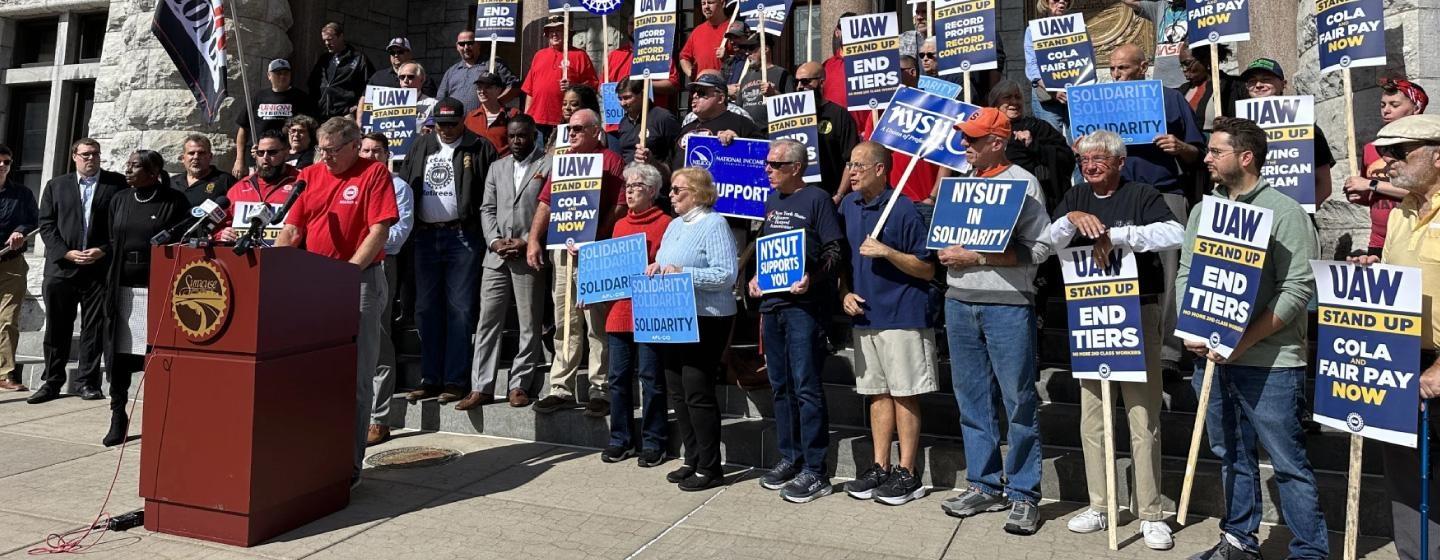Federal Child Care Funding Is Ending. NYS Could Lose a Third of Its Providers

Federal Child Care Funding Is Ending. NYS Could Lose a Third of Its Providers
The COVID-19 pandemic revealed just how crucial child care is to a healthy economy. It also exposed how fundamentally unstable the U.S. child care industry is.
Federal and state governments have infused a historic amount of money into child care to try and solve the problem. But that just kicked many systemic issues a little further down the road.
With federal child care support from the American Rescue Plan Act set to expire on September 30, the end of the road is here.
That has child care providers, experts, and politicians asking: what’s next?
The child care fiscal cliff and what's at stake
Over the last two years, the federal government distributed $24 billion to childcare providers in the form of stabilization grants. That money paid for childcare salaries and overhead costs and helped fill the financial holes left behind by unstable enrollment, a workforce shortage, and inflation.
"For the last few years, many providers have used the stabilization dollars to plug the hole," said Steve Dwek, the CEO of Healthy Kids Programs, a company that runs about 120 childcare locations in the northeast, many in New York.
He says the profit margins in child care got even thinner these past years.
"If you take a look at minimum wage going from $11/hr to $15/hr, that means our payroll has gone up by 30%," said Dwek. But he says parents’ ability to pay has not increased, "and that is what has squashed the margins."
Dwek says many providers are currently losing money month-to-month, and that the stabilization dollars have helped mask that. With that federal funding expiring at the end of the month, Dwek says the fear is that "many child care providers are not going to be able to pay their bills, and will not be sustainable."
One study from The Century Foundation, a think tank that does public policy research, estimates that New York State could lose about a third of its 18,000 childcare programs.
U.S. Sen. Kirsten Gillibrand called it “the looming child care cliff” at a press conference in mid-August.
"The child care stabilization grant fund is set to expire at the end of September. In New York, that means more than 250,000 children could lose care," Gillibrand said.
Funding for child care from the federal government, on an annual basis
To keep that from happening, Gillibrand is the co-sponsor of a new piece of legislation, called the Child Care Stabilization Act. Nationwide, it would provide $16 billion dollars per year to childcare providers for the next five years and help to cover the costs of wages, benefits, rent, utilities, and supplies.
Gillibrand says this kind of funding is important because access to child care is essential for working families.
"It allows them to succeed in their careers and continue contributing to our national economy," said Gillibrand. "It increases labor force participation, reduces absenteeism among workers, and helps contribute to the child’s future."
If the Child Care Stabilization Act is passed by Congress, it would be a huge step closer to the ultimate dream of many advocates: government-funded early childhood education.
That would mean childcare providers would be funded, "regardless of the income potential of the families that are enrolled there," said Alder Rose Blanchard, a childcare provider-turned-advocate in Saranac Lake.
But as much as Blanchard and other childcare advocates would love to see that happen, they're not holding their breath when it comes to the new legislation.
"So that money has to come from somewhere," said Blanchard, "and there are a lot of areas of human services that need help and support, right?"
In the current political climate, Blanchard fears the Child Care Stabilization Act is unlikely to pass. Right now, Sen. Gillibrand said it has 38 Democratic co-sponsors, but no Republican co-sponsors. And if it does pick up new sponsors, the bill wouldn’t pass for months, long after the September 30 fiscal cliff passes.
So Steve Dwek, the CEO of Healthy Kids, said they have to assume they’re back where they were before the pandemic: on their own.
"If there is no increase, or there’s no public support, how does the industry survive?" asked Dwek.
Long-term fixes instead of temporary band-aids
As helpful as the COVID-era federal funds were, Alder Rose Blanchard said it was temporary and designed as a band-aid. "That funding only stabilized the short term, it didn’t make allowances for any savings or longevity," Blanchard said. Because it was a response to a crisis, it didn’t address bigger systematic issues that have existed for decades, they added.
Blanchard said even the new bill would still be a short-term solution, focused on plugging the holes of a fundamentally unsustainable childcare system.
What the industry has to focus on now, said Blanchard, is long-term support and solutions.
"What we need to be working on now, is how do we ensure these providers are around in 20, 25, 30 years?" asked Blanchard.
Steve Dwek, the CEO of Healthy Kids, says the childcare industry and the government need to think creatively and "out-of-the-box" about child care.
He says one of the big issues is a lack of childcare workers. He wonders about expanding the applicant pool to include people who are already doing a lot of this work.
“I can tell you every day, older siblings and grandparents are providing the backbone of child care. Is there ways that the industry could embrace that somehow?" he said.
Dwek pointed to how New York lowered the age of lifeguards this past summer to address a worker shortage there. He suggested the state could think about doing the same for 17-year-olds and after-school childcare programs.
"They finish their high school day at one, they just walk over to the elementary school. They could be really great," said Dwek.
Dwek also says the industry needs to lean into technology to help reduce the time providers spend doing mountains of paperwork: things like payroll systems, onboarding new families, and submitting childcare assistance forms.
"If you’re doing it all manually it’s really time-consuming and there’s such a chance that something is going to fall through the cracks," he said.
Dwek’s company, Healthy Kids, doubled the number of their locations in the last few years by centralizing administration. "The administrative departments, HR, finance, and marketing, they do all the back office stuff, so program staff, all they have to worry about is the kids."
Innovation and shared services in the public sector
Most child care in the North Country is made up of individual operations, run by one or two women out of their homes, while Healthy Kids is a large, private company that is investing in new systems and technology.
But public organizations are looking to do similar things to help those individual operators make it.
Alder Rose Blanchard, the provider-turned-advocate in the Adirondacks, now works for the Child Care Coordinating Council of the North Country (CCCCNC), which serves Clinton and Franklin counties. The CCCCNC is partnering with two other regional child care agencies, ACAP in Essex and the Southern Adirondack Child Care Network in Warren, Hamilton, and Washington, to establish a 'shared services network'.
The idea is to bundle together services and goods that child care providers need, including "equipment, materials, purchasing, personnel, at a reduced cost to child care providers," said Blanchard. "The more that participate, the lower the rates could be."
They’re calling it the Northeastern Shared Services Alliance and hope to launch sometime this fall. They’ll start by coordinating group purchasing for goods and services, like "plowing in the winter time, grounds maintenance, and cleaning," Blanchard said.
Eventually, they want to provide administrative support in the way Healthy Kids does: payroll, HR, and even filing for childcare assistance.
"Every reduction in administrative burden and cost has a substantial impact on the longevity of programs," Blanchard said.
Blanchard says they’re currently looking for local businesses to join the shared services network. "So everyday businesses can help with this, right now, today."
Blanchard says it will take everything to make child care work: federal and state funding, but also personal relationships, and also a willing community, "that focuses on child care as essential and valued."
Related

Union Members in Syracuse Rally in Support of Striking Auto Workers
Striking union workers in Michigan have the support of central New York politicians and union members, as dozens rallied on the steps of Syracuse City Hall Wednesday to show their support.


